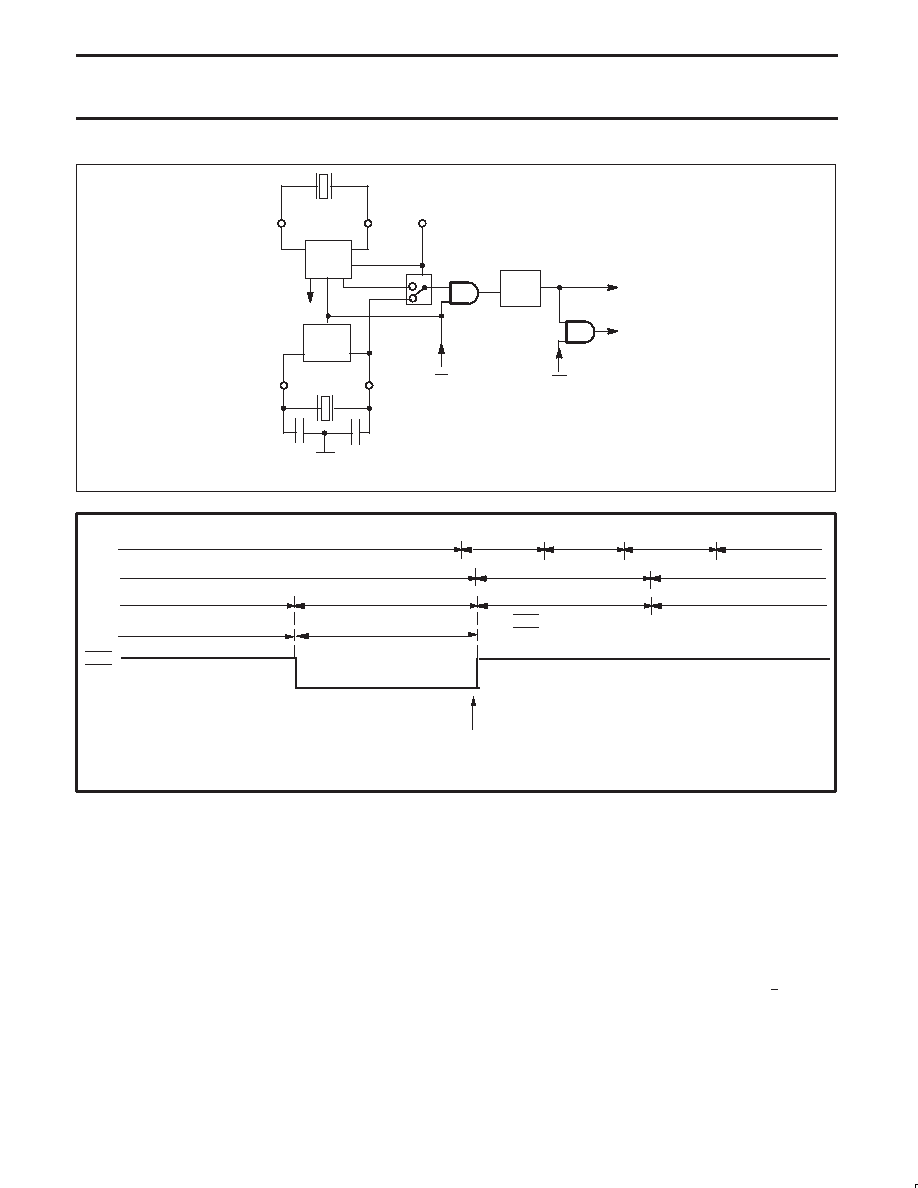- 您現(xiàn)在的位置:買賣IC網(wǎng) > PDF目錄24826 > 935268065557 (NXP SEMICONDUCTORS) 8-BIT, MROM, 16 MHz, MICROCONTROLLER, PQFP80 PDF資料下載
參數(shù)資料
| 型號(hào): | 935268065557 |
| 廠商: | NXP SEMICONDUCTORS |
| 元件分類: | 微控制器/微處理器 |
| 英文描述: | 8-BIT, MROM, 16 MHz, MICROCONTROLLER, PQFP80 |
| 封裝: | PLASTIC, QFP-80 |
| 文件頁數(shù): | 37/76頁 |
| 文件大?。?/td> | 567K |
| 代理商: | 935268065557 |
第1頁第2頁第3頁第4頁第5頁第6頁第7頁第8頁第9頁第10頁第11頁第12頁第13頁第14頁第15頁第16頁第17頁第18頁第19頁第20頁第21頁第22頁第23頁第24頁第25頁第26頁第27頁第28頁第29頁第30頁第31頁第32頁第33頁第34頁第35頁第36頁當(dāng)前第37頁第38頁第39頁第40頁第41頁第42頁第43頁第44頁第45頁第46頁第47頁第48頁第49頁第50頁第51頁第52頁第53頁第54頁第55頁第56頁第57頁第58頁第59頁第60頁第61頁第62頁第63頁第64頁第65頁第66頁第67頁第68頁第69頁第70頁第71頁第72頁第73頁第74頁第75頁第76頁

Philips Semiconductors
Product specification
P83C557E4/P80C557E4/P89C557E4
Single-chip 8-bit microcontroller
1999 Mar 02
42
Clock
Gen.
Interrupts,
Serial
Ports,
T0, T1, T3
XTAL4
XTAL3
Figure 40. Idle and Power Down Hardware for Clock Generation
XTAL1
XTAL2
3.5 to
16 MHz
Osc
fCLK
CPU
T2
ADC
PWM
32 kHz
PLL
Osc
Seconds timer
PD
IDL
SELXTAL1
Figure 41. Wake-up by interrupt
INT0
INT1
set External Interrupt latch
INT0 : 2 cycles
INT1 : 1 cycle
Internal timing stopped
C1
C2
Power-down Mode
Idle Mode
LCALL
oscillator stopped
oscillator start_up
interrupts are polled
Interrupt routine
> 10 ms
> 560 ms
> 10 ms
XTAL1,2
32 kHz oscillator stopped
running
6.11.1
Power Control Register
The modes Idle and Power-down are activated by software via the
Special Function Register PCON. Its hardware address is 87H.
PCON is not bit addressable. The reset value of PCON is
(00000000).
6.11.2
Idle Mode
The instruction that sets PCON.0 is the last instruction executed in
the normal operating mode before Idle Mode is activated. Once in
the Idle Mode, the CPU status is preserved in its entirety: the Stack
Pointer, Program Counter, Program Status Word, Accumulator, RAM
and all other registers maintain their data during Idle Mode. The
status of external pins during Idle Mode is shown in Table 40.
There are three ways to terminate the Idle Mode:
Activation of any enabled interrupt X0, T0, X1, SEC, T1, S0 or S1
will cause PCON.0 to be cleared by hardware terminating Idle Mode
but only, if there is no interrupt in service with the same or higher
priority. The interrupt is serviced, and following return from interrupt
instruction RETI, the next instruction to be executed will be the one
which follows the instruction that wrote a logic 1 to PCON.0.
The flag bits GF0 and GF1 may be used to determine whether the
interrupt was received during normal execution or during Idle Mode.
For example, the instruction that writes to PCON.0 can also set or
clear one or both flag bits. When Idle Mode is terminated by an
interrupt, the service routine can examine the status of the flag bits.
The second way of terminating the Idle Mode is with an external
hardware reset. Since the oscillator is still running, the hardware
reset is required to be active for two machine cycles (24 HF
oscillator periods) to complete the reset operation if the HF oscillator
is selected.
When the PLL oscillator is selected a hardware reset of > 1
sec
(but no longer than 10 ms) is required and the microcontroller will
typically restart within 63 msec after the reset has finished.
The third way of terminating the Idle Mode is by internal watchdog
reset. The microcontroller restarts after 3 machine cycles in all
cases.
相關(guān)PDF資料 |
PDF描述 |
|---|---|
| 935263263557 | 8-BIT, MROM, 16 MHz, MICROCONTROLLER, PQFP80 |
| 935263262557 | 8-BIT, MROM, 16 MHz, MICROCONTROLLER, PQFP80 |
| 935263208557 | 8-BIT, MROM, 16 MHz, MICROCONTROLLER, PQFP80 |
| 935263156518 | 8-BIT, FLASH, 16 MHz, MICROCONTROLLER, PQFP80 |
| 08-XC62H | TV 10C 10#20 PIN PLUG RECP |
相關(guān)代理商/技術(shù)參數(shù) |
參數(shù)描述 |
|---|---|
| 935268081112 | 制造商:NXP Semiconductors 功能描述:SUB ONLY IC |
| 935268721125 | 制造商:NXP Semiconductors 功能描述:Buffer/Line Driver 1-CH Non-Inverting 3-ST CMOS 5-Pin TSSOP T/R |
| 935269304128 | 制造商:ST-Ericsson 功能描述:IC AUDIO CODEC W/TCH SCRN 48LQFP |
| 935269544557 | 制造商:NXP Semiconductors 功能描述:SUB ONLY TDA9587-2US1-V1.3 |
| 935269987557 | 制造商:NXP Semiconductors 功能描述:SUB ONLY TDA9587-1US1-V1.8 SUBBED TO 935269987557 |
發(fā)布緊急采購(gòu),3分鐘左右您將得到回復(fù)。